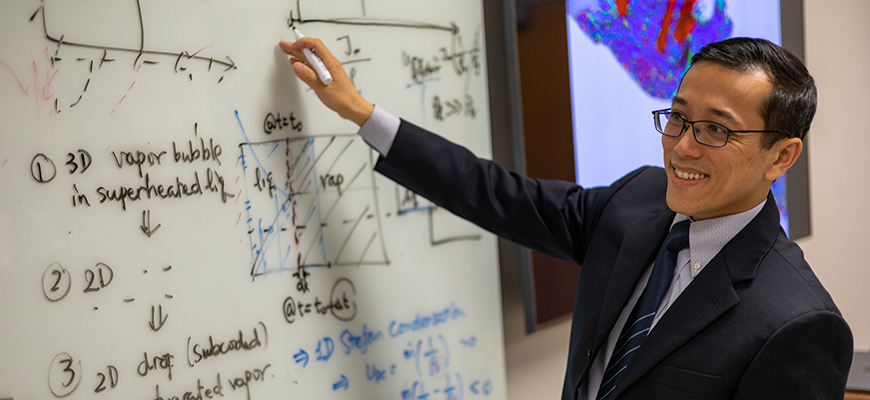
Solving the unanswered questions
Stanley Ling, a new faculty member in the College of Engineering and Computing, hopes to expand the world of engineering by answering fundamental questions.
Posted on: November 28, 2022; Updated on: November 28, 2022
By Hannah Cambre, hcambre@mailbox.sc.edu, 803-777-2930
How can I design an engine that offers excellent gas mileage while producing as little pollution as possible? This is the type of question that keeps modern mechanical engineers awake at night. For Stanley Ling, the question looks a little different. His goal isn’t to design the world’s most efficient engine — he’d rather figure out the fundamental theory behind how energy and heat transfer work so that other scientists have the tools to answer their pressing questions.
As a young boy growing up in China, Ling had a love for math and physics, but his career path was shaped by more than just enjoyment. “I didn’t want to do research out of curiosity and for fun,” he explains. “I chose engineering because I want to solve problems.”
After completing his undergraduate studies in engineering mechanics at Beihang University in 2004, he decided to pursue his doctorate in the United States. In 2010, he completed his Ph.D. in mechanical engineering at the University of Florida, where he stayed for two more years to conduct postdoctoral research. Soon, he realized he wanted to see more of what the world of mechanical engineering had to offer. That’s what brought him to Paris.
“We did not have a lot of people doing fluid mechanics, so we were lucky to get Stanley, who does this at an internationally outstanding level."
Hossein Haj-Hariri, dean of the USC College of Engineering and Computing
At Sorbonne University’s Institut Jean Le Rond d’Alembert, Ling was afforded the opportunity to continue his postdoctoral work alongside high-caliber researchers at one of Europe’s most highly acclaimed research schools. The university’s labs are connected to national research centers, so Ling had access to the resources and researchers that have helped establish the Sorbonne as a well-respected name in fluid mechanics and computer modeling.
It was a transformative experience, one that would shape the trajectory of his career. He says, “I decided that, yes, I wanted that for the rest of my life.”
From Paris, Ling moved to Texas, where he began his career in academia at Baylor University. At the critical juncture of tenure evaluations, Ling decided to take a risk and seek out a university where he could challenge the limits of his research even further.
Ling found that opportunity at the University of South Carolina, where he was thoroughly impressed by the high-performance computing capabilities. There are two main approaches to mechanical engineering: one relies on measuring results using equipment in a lab, while the other uses highly advanced computer simulations to predict outcomes. Ling’s research relies on the latter.
Using simulations, Ling hopes to address fundamental questions about physics that are still troubling engineers — those questions that have not been resolved by repeatedly reproducing physical results in a laboratory. He believes simulations are key to providing the knowledge to solve a host of application questions, and better computers make for better results from simulations.
Ling is excited about the future of mechanical engineering and the research he will do at USC. In particular, he is eager to use the additional computing resources that the College of Engineering and Computing plans to acquire next year. He is excited to work alongside colleagues in the college’s large, comprehensive mechanical engineering department on pressing fluid mechanics questions.
Travis Knight, department chair of mechanical engineering, says, “He's found a number of collaborations very early on, and that’s a testament to the value of what he brings to the table in terms of research capabilities and diversity of applications.”
Hossein Haj-Hariri, dean of the College of Engineering and Computing, is also eager to add Ling to the impressive roster of high-caliber faculty members the college has recruited since 2016. After starting a highly successful aerospace engineering program that also draws heavily from the mechanical engineering faculty, Haj-Hariri knew he needed someone to fill in a critical gap. Ling was the ideal candidate.
“We did not have a lot of people doing fluid mechanics, so we were lucky to get Stanley, who does this at an internationally outstanding level,” says Haj-Hariri. He is confident that, in addition to the college’s state-of-the-art labs and impressive facilities, Ling and instructors like him will be an asset to the university’s aspiring engineering students as well as its research profile and faculty collaboration. It will also continue the college’s recent record of hiring world-class researchers.
“Once the word gets out that we are hiring people of that caliber, it gets easier,” Haj-Hariri says. “When we bring people in for interviews, they want to be here.”
Editor’s Note: Ling joins the College of Engineering and Computing along with colleagues Golareh Jalilvand, assistant professor of chemical engineering; Forest Agostinelli and Christian O’Reilly, assistant professors of computer science and engineering; and Kristen Booth, assistant professor of electrical engineering.